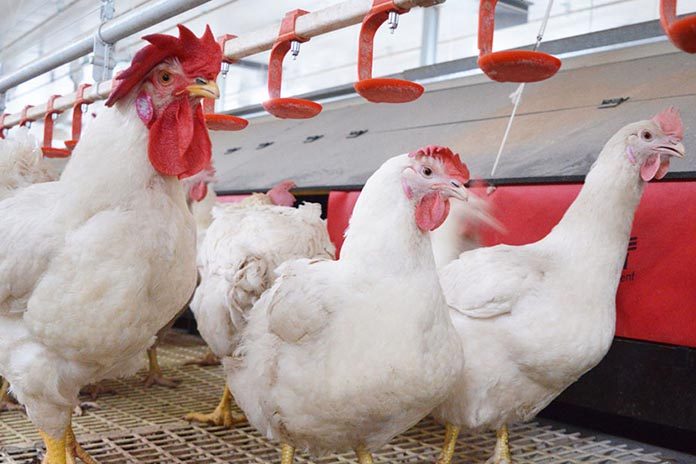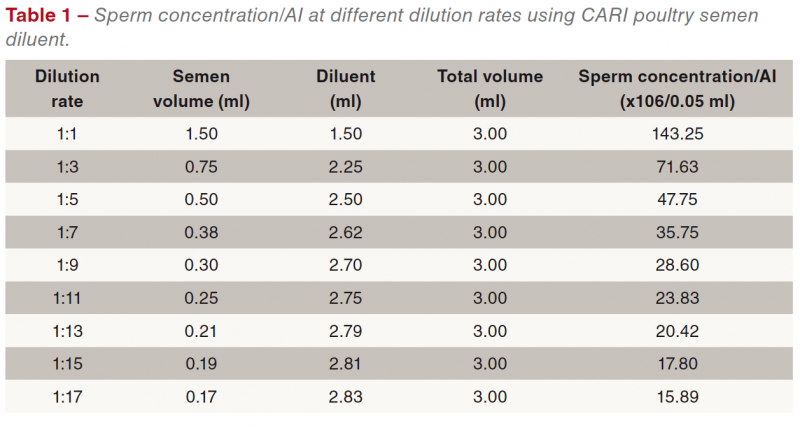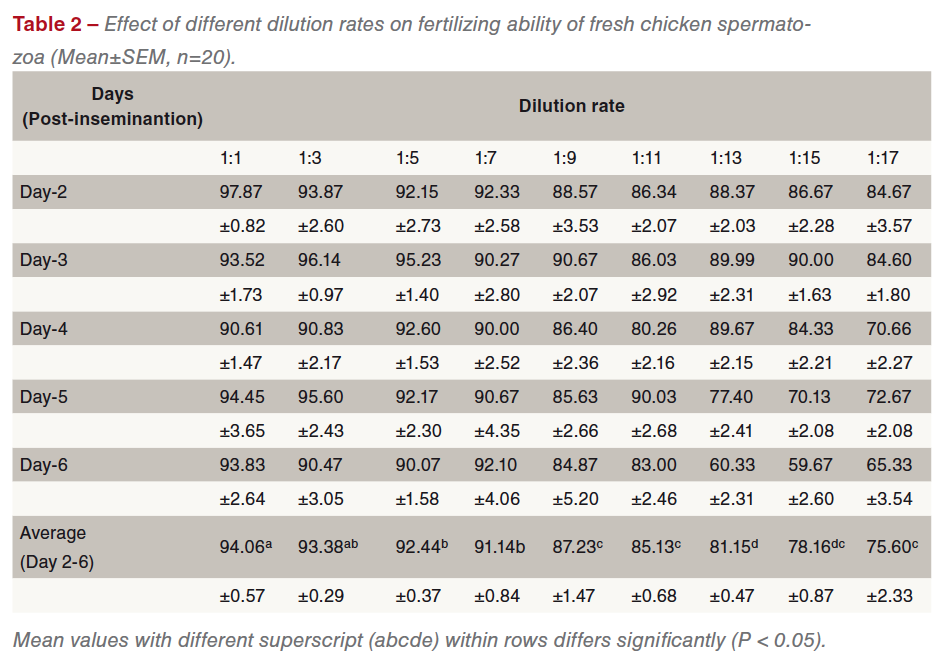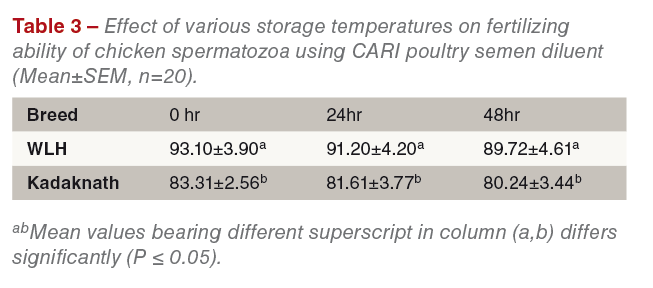
Under natural mating, with a ratio of hen:cocks of 8:1 fertility rates are still low. Artificial insemination (AI) technology can be adopted and is the most effective means for economic poultry production and genetic improvement. The effect of different dilution rates of freshly ejaculated white leghorn chicken (WLH) semen was investigated using CARI poultry semen diluent.
Healthy adult males and 180 healthy adult hens from the same hatch were taken randomly and maintained in individual cages under uniform husbandry conditions. The hens were divided equally and randomly into 9 groups. Good quality pooled fresh semen samples were collected by massage method and diluted with CARI poultry semen diluent at different dilution rates. Using the freshly ejaculated semen, superior fertility was obtained from 2 to 6 days post insemination with dilution rate of 1:1 and the dilution rate of semen was associated with the gradual reduction in fertility.
In another study, fertilizing ability of CARI poultry semen diluent was examined at different storage periods at 8±1 °C in WLH and Kadaknath chicken. Adult healthy males (20) and females (60) from each breed were selected randomly and maintained under similar conditions. Fertility was higher in WLH than in Kadaknath chickens but was not significantly affected in either breed by storage for 24 or 48 hours. From this study, it can be concluded that freshly ejaculated chicken semen can be extended up to 1:7 in CARI diluent without critical loss in fertility. Further, this diluent can be used for 24 or 48 hours storage of chicken semen with maintenance of high fertility.
Introduction
Using artificial insemination (AI), the services of a single superior male can be extended to a large number (more than 250) of females instead of 8 hens (natural mating). AI in avian species expresses better fertility than natural mating. AI increases overall fertility and hatchability with reduced cost of production per day old chick. Adopting AI needs fewer males which saves feed, labour, space, maintenance and operating costs but requires the immediate dilution of chicken semen because it is highly concentrated, containing 6 (roosters) to 12 (toms) billion spermatozoa/ml and has a low volume. There is the risk of sperm being killed by dehydration resulting from evaporation of water at room temperature from highly concentrated semen unless semen is diluted and semen diluent can increase the number of hens that can be inseminated by the semen provided by a single superior male.
Various semen diluents are available as reported in the literature but CARI poultry semen diluent produces good results. Therefore, CARI diluent developed in our laboratory was selected to investigate the appropriate dilution rate of this diluent for optimum fertility. Further, the fertilizing ability of this diluent was also examined at 0, 24 and 48 hours of storage of diluted semen.
Materials and methods
Healthy adult males (20) and females (180) from the same hatch of WLH chicken were taken randomly and maintained in individual cages under uniform husbandry conditions. Good quality semen samples were collected by the Burrows and Quinn method, in 1937. For examining the fertility in fresh samples, pooled semen (sperm concentration 5.73×109/ml) was placed in 9 round bottom glass tubes of 5 ml capacity (length=7cm, diameter =1cm). All the tubes containing varying semen volume were diluted with CARI diluent at the rate of 1:1, 1:3, 1:5, 1:7, 1:9, 1:11, 1:13, 1:15 and 1:17 to achieve the final fixed volume of 3 ml in each tube (Table 1). Immediately after dilution, the sperm concentration was examined using a haemocytometer.

AI with freshly ejaculated semen was carried out by intravaginal insemination using an AI gun (IMV, France) in 9 different groups each of 20 hens. Fertile eggs were collected from 2-6 days of post insemination of hens and examined by candling at the 9th day of incubation. Break out studies were performed for the fertility assessment where fertility was not clear by candling. In another study, 20 healthy adult males and 60 females from the same hatch of WLH (exotic) and Kadaknath (native) chicken were taken randomly and maintained in individual cages under uniform husbandry conditions as in the above experiment.
All hens in this study were divided equally into 3 groups (20 each). The first group of hens received the freshly ejaculated semen (0 hour stored) diluted (1:2) with CARI poultry semen diluent and served as control. The second and third groups of birds received the semen diluted (1:2) with CARI poultry semen diluent and stored in 5 ml capacity glass vial at 8±1 °C for 24 and 48 hours respectively before insemination of hens. AI and evaluation of fertility were conducted as described in experiment 1. Data were analysed as per the standard methods.
Results and discussion
Data on the effect of different dilution rates on fertilizing ability of freshly ejaculated chicken spermatozoa are presented in Table 2. Superior fertility was obtained from 2 to 6 days post insemination for the dilution rate of 1:1 (143.00), 1:3 (71.50) 1:5 (47.75) and 1:7 (35.75 million (m) sperm/AI) which ranged from 91 to 94%. With higher dilution rates i.e. 1:9 (28.60 m sperm/AI) and 1:11 (23.83 m sperm/AI), fertilizing ability of sperm reduced to 87.23 and 85.13% respectively. Further increases in the dilution rate like 1:13 (20.42 m sperm/AI), 1:15 (17.88 m sperm/AI) and 1:17 (15.89×106 m sperm/AI), reduced fertility further at 81.15, 78.16 and 75.60% respectively.

According to this study, a minimum 36 million sperm (1:7) are required for good fertility in chickens. The results of this study are similar to the work carried out by Beulah, who used freshly ejaculated diluted chicken semen with CARI diluent and recorded above 90 % fertility up to 1:8 (29.70×106 sperms/AI) dilution rate and 79% fertility at 1:18 (14.70 m sperm/AI). The reduction of fertility with higher dilution rate is associated with the decrease in number of spermatozoa per unit volume. The minimum number of sperm required per AI is 45 to 90 million /hen for good fertility in chickens although Etches, in 1996, advocated 100 million sperm /hen/AI.
Results on the effect of CARI diluent on storage of chicken semen at 24 or 48 hours are presented in Table 3.

In the exotic breed of chicken, fertility rates at 0 (fresh/ control), 24 and 48 hours were 93.10±3.90, 91.20±4.20 and 89.72±4.61% respectively and in native breeds 82.31±2.56, 81.61±3.77 and 80.24±3.44% respectively. These data indicate that no significant difference was found in fertility among the three storage periods in both breeds. However, a lower (P < 0.05) fertility was found in Kadaknath as compared with the WLH breed. This may be due to breed to breed variation. Mohan et al., in 2011, also reported higher fertility in WLH than Kadaknath. Poor fertility in native fowl during storage of spermatozoa may be associated with more dead and morphologically abnormal spermatozoa than for WLH. High fertility depended more on semen quality than semen quantity. This investigation indicated that chicken semen can be stored (8±1 °C) for 24 or 48 hours in CARI diluent and still express high fertility similar to the freshly ejaculated semen (see Table 3). However, earlier studies indicated that chicken semen can be stored for 24 hours at 0-5 °C. This suggested that the composition of the CARI poultry semen diluent may differ from others and preserve the chicken semen at 8±1 °C (instead of 0-5 °C) up to 48 hours without impairing the fertility (89.72±4.60%). Adequate data are not available on 48 hours stored semen to compare with ours. However, Lake in 1960 reported 47 % fertility after 48 hours storage of semen at 0-2 °C, nearly half that of the present study.
Conclusion
Using CARI diluent, freshly ejaculated chicken semen can be extended up to 1:7 without significant loss in fertility. This diluent can be used for 24 or 48 hours storage of chicken semen with high fertility.
References are available on request
From the Australian Poultry Science Symposium 2019

















